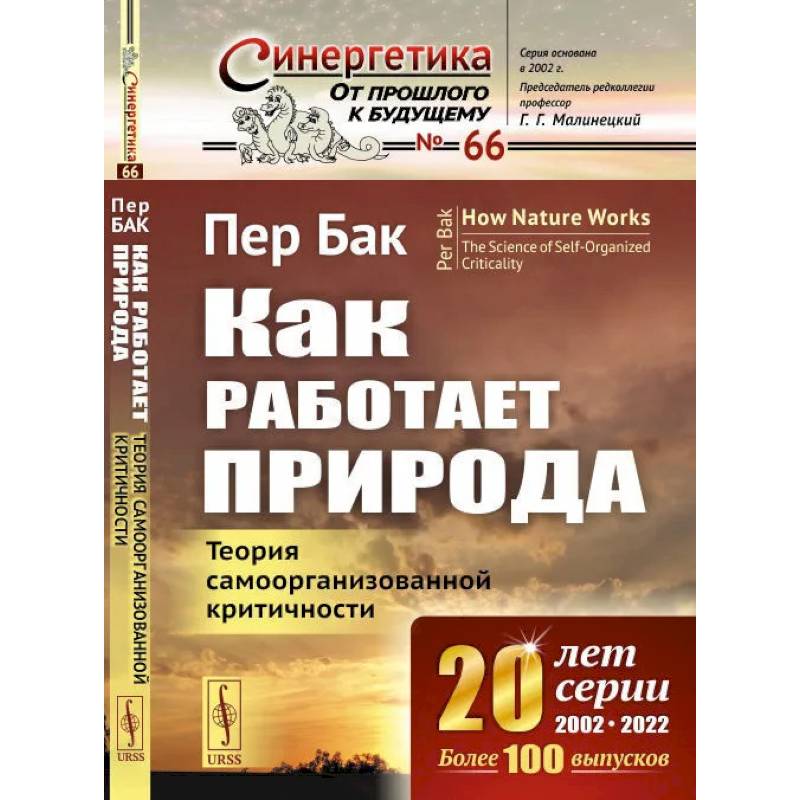How nature works: self-organized criticality theory. 2nd edition
Please sign in so that we can notify you about a reply
Why do you need the theory of complex systems? And how did this author dare to give the book the such loud name: "How is nature work?
The answer is simple and laconic --- unlike other theories describing certain separate complex systems, self-organized criticality --- The first general theory of complex systems based on a solid mathematical foundation.
The tank is the discoverer of self-organized criticality --- a concept that gains more and more weight in modern science. It turns out that many, in no way connected, at first glance, with each other, the phenomenon --- from the formation of the landscape to evolutionary processes, from the activities of the nervous system to economic behavior-have a number of common properties. Such properties are called emergent. The swing of the "magic wand" theory of self -organized criticality illuminated all this diversity and allowed to see the inner unity. What is it overwhelmed with? Firstly, in the property of intermittent equilibrium: long periods of relative rest from time to time are interrupted by disasters ("avalanches") of various scales. This can be both an avalanche in the literal sense of the word, or a variety of crisis phenomena --- mass extinction of species, collapse and rally of shares, solar outbreaks or the appearance and disappearance of structures in cell assets. Secondly, in the steppe laws: the ratio between the size of the avalanches can be described by a simple exponential formula. No special theories are required for large-scale events --- the same forces are responsible for the current decrease in the DOU-Jones index by 5 points, and for the Black Monday of 1987. Thirdly, fractal geometry: self-melodies are inherent in the system on any scale. And finally, in the characteristic 1/F-shum, when, with the development of a system in time, the recording of its evolution is also fractal.
These features are so similar that, as the author writes, this makes you think: is it all the manifestations of one principle? Maybe there is a certain analogue of the Newtonian law, its f = ma of complex behavior? " The laboe convincingly shows that self-organized criticality is a spontaneous evolution of systems to a critical state --- and is the key to understanding this single principle.
This popular science book opens up an exciting view of the horizons of tomorrow"s science, it is unique in the holistic picture that it creates with the reader, gives a guiding thread and a set of basic models that help to understand what is happening and offer tools for describing it, and It also helps to rethink an understanding of many events and phenomena of the world.
The book is designed for a wide range of readers
The answer is simple and laconic --- unlike other theories describing certain separate complex systems, self-organized criticality --- The first general theory of complex systems based on a solid mathematical foundation.
The tank is the discoverer of self-organized criticality --- a concept that gains more and more weight in modern science. It turns out that many, in no way connected, at first glance, with each other, the phenomenon --- from the formation of the landscape to evolutionary processes, from the activities of the nervous system to economic behavior-have a number of common properties. Such properties are called emergent. The swing of the "magic wand" theory of self -organized criticality illuminated all this diversity and allowed to see the inner unity. What is it overwhelmed with? Firstly, in the property of intermittent equilibrium: long periods of relative rest from time to time are interrupted by disasters ("avalanches") of various scales. This can be both an avalanche in the literal sense of the word, or a variety of crisis phenomena --- mass extinction of species, collapse and rally of shares, solar outbreaks or the appearance and disappearance of structures in cell assets. Secondly, in the steppe laws: the ratio between the size of the avalanches can be described by a simple exponential formula. No special theories are required for large-scale events --- the same forces are responsible for the current decrease in the DOU-Jones index by 5 points, and for the Black Monday of 1987. Thirdly, fractal geometry: self-melodies are inherent in the system on any scale. And finally, in the characteristic 1/F-shum, when, with the development of a system in time, the recording of its evolution is also fractal.
These features are so similar that, as the author writes, this makes you think: is it all the manifestations of one principle? Maybe there is a certain analogue of the Newtonian law, its f = ma of complex behavior? " The laboe convincingly shows that self-organized criticality is a spontaneous evolution of systems to a critical state --- and is the key to understanding this single principle.
This popular science book opens up an exciting view of the horizons of tomorrow"s science, it is unique in the holistic picture that it creates with the reader, gives a guiding thread and a set of basic models that help to understand what is happening and offer tools for describing it, and It also helps to rethink an understanding of many events and phenomena of the world.
The book is designed for a wide range of readers
Author:
Author:Пер Бак
Cover:
Cover:Hard
Category:
- Category:Comics and Graphic Novels
- Category:History & Geography
- Category:Reference books
- Category:Natural sciences
Publication language:
Publication Language:Russian
Paper:
Paper:Offset
ISBN:
ISBN:978-5-453-00223-8
No reviews found
